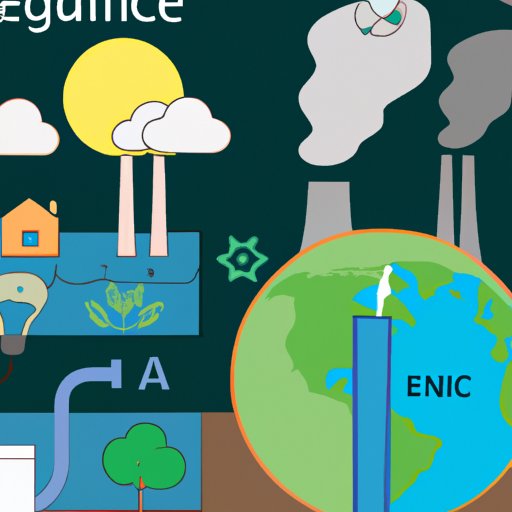Introduction
Technology is a term that refers to any tools, machines, systems, or methods used to solve problems or perform tasks. It has revolutionized our lives over the last century, allowing us to accomplish more in less time and make everyday activities easier. However, while technology has many benefits, it can also have a negative impact on the environment. In this article, we will explore how technology affects the environment and discuss potential solutions for reducing pollution and protecting the environment.

Impact of Technology on Air Quality
One of the most significant environmental impacts of technology is air pollution. Burning fossil fuels such as coal, oil, and natural gas releases pollutants into the atmosphere, including carbon dioxide, sulfur dioxide, nitrogen oxides, and particulate matter. These pollutants can cause a variety of health problems, including asthma, bronchitis, heart disease, and lung cancer. Additionally, they can contribute to climate change by trapping heat in the atmosphere and increasing global temperatures.
Vehicles are another major source of air pollution. According to a study published in the journal Environmental Pollution, motor vehicles account for nearly one-third of all air pollution worldwide. The emissions from cars, trucks, buses, and other vehicles contain hazardous pollutants such as carbon monoxide, nitrogen oxides, and volatile organic compounds. These pollutants can contribute to smog and acid rain, which can harm plants, animals, and ecosystems.
Fortunately, there are technologies available that can help reduce air pollution. For example, electric vehicles (EVs) produce significantly fewer emissions than traditional gasoline-powered vehicles. Additionally, many governments have implemented regulations to reduce emissions from vehicles, such as requiring the use of cleaner fuels and more efficient engines. Finally, renewable energy sources such as solar, wind, and hydroelectricity can replace the need for fossil fuels and reduce air pollution.

The Role of Technology in Reducing Waste and Pollution
Another way in which technology can help protect the environment is by reducing waste and pollution. Recycling technologies allow us to reuse materials instead of throwing them away, thus reducing the amount of waste that ends up in landfills. Additionally, waste management technologies such as incinerators and composting can convert waste into energy or fertilizer, reducing the amount of waste that must be disposed of in landfills.
Reusing resources is another effective way to reduce waste and pollution. By using items multiple times before disposing of them, we can reduce our reliance on new resources and prevent them from ending up in landfills. This can be done through simple practices such as reducing, reusing, and recycling, as well as more advanced technologies such as 3D printing.
Energy Consumption and Conservation with Technology
Technology can also play an important role in reducing energy consumption and conserving resources. Technologies such as LED lighting and smart appliances can increase efficiency and reduce energy consumption. Additionally, renewable energy sources such as solar and wind can replace the need for fossil fuels and reduce our reliance on finite resources. Finally, smart grid technologies can automate energy distribution and reduce waste.

The Relationship Between Technology and Water Pollution
Water pollution is another major environmental issue caused by technology. Agricultural technologies such as fertilizers and pesticides can leach into waterways, polluting rivers and lakes. Additionally, industrial wastewater treatment technologies are often inadequate, allowing pollutants to enter waterways. Finally, desalination technologies, which remove salt from seawater, can generate large amounts of brine, which can also contaminate local waterways.
Fortunately, there are technologies available that can help reduce water pollution. For example, agricultural technologies such as soil erosion control measures and cover crops can reduce the amount of fertilizer and pesticide runoff. Additionally, industrial wastewater treatment technologies can be improved to better filter out pollutants. Finally, desalination technologies can use reverse osmosis to reduce the amount of brine produced.
Technology and Wildlife Habitat Destruction
Technology can also have a direct and indirect impact on wildlife habitats. Direct effects include habitat destruction due to urbanization, deforestation, and construction of infrastructure. Indirect effects include pollution from vehicles and industry, as well as increased noise and light pollution. All of these factors can disrupt ecosystems and harm wildlife populations.
Fortunately, there are technologies available that can help protect wildlife habitats. For example, remote sensing technologies can be used to monitor wildlife populations and detect illegal activities such as poaching. Additionally, green building technologies can reduce habitat destruction by minimizing the impact of construction. Finally, wildlife corridors and habitat restoration technologies can be used to create and maintain habitats for wildlife.
Climate Change and the Use of Technology
Finally, technology can also play an important role in addressing climate change. Human activities such as burning fossil fuels and deforestation have contributed to an increase in atmospheric carbon dioxide levels, leading to global warming. To mitigate the effects of climate change, researchers are developing technologies that reduce emissions and adapt to the changing climate.
Climate change mitigation technologies include renewable energy sources such as solar, wind, and hydroelectricity. These technologies can replace the need for fossil fuels and reduce emissions. Additionally, technologies such as carbon capture and storage can capture and store carbon dioxide, preventing it from entering the atmosphere. Finally, technologies such as drought-resistant crops and flood barriers can help communities adapt to the changing climate.
Conclusion
Technology has revolutionized our lives over the last century, but it can also have a negative impact on the environment. In this article, we explored how technology affects the environment, including its impact on air quality, waste, energy, water, wildlife, and climate change. Fortunately, there are technologies available that can help reduce pollution and protect the environment.
(Note: Is this article not meeting your expectations? Do you have knowledge or insights to share? Unlock new opportunities and expand your reach by joining our authors team. Click Registration to join us and share your expertise with our readers.)
